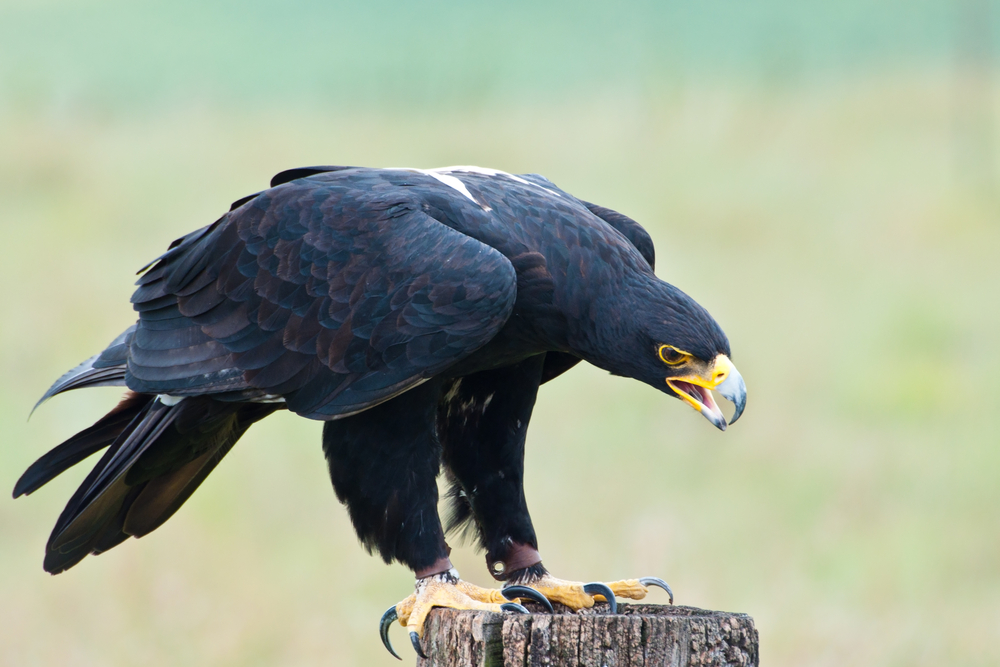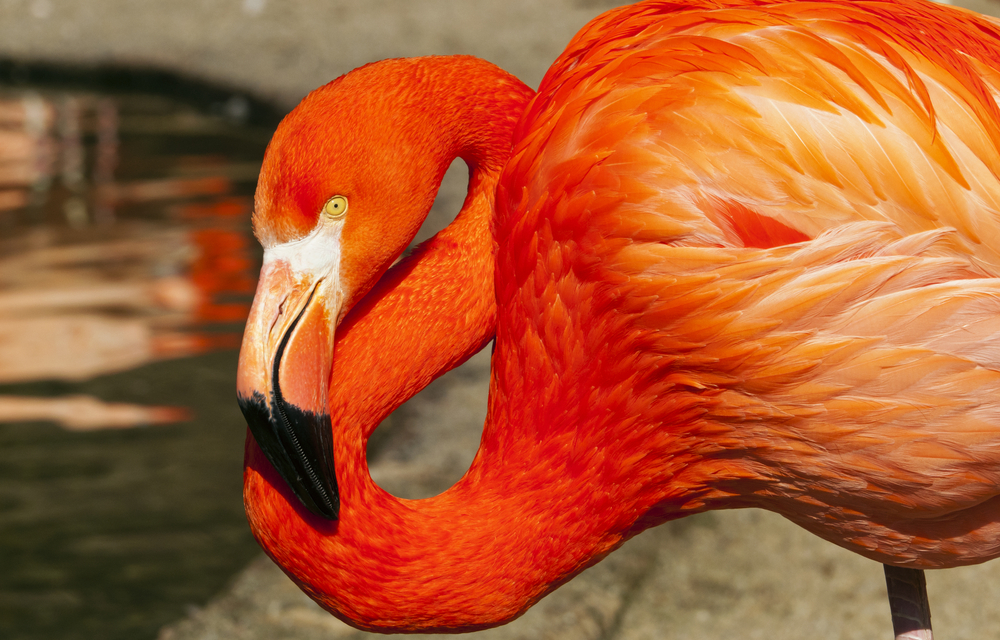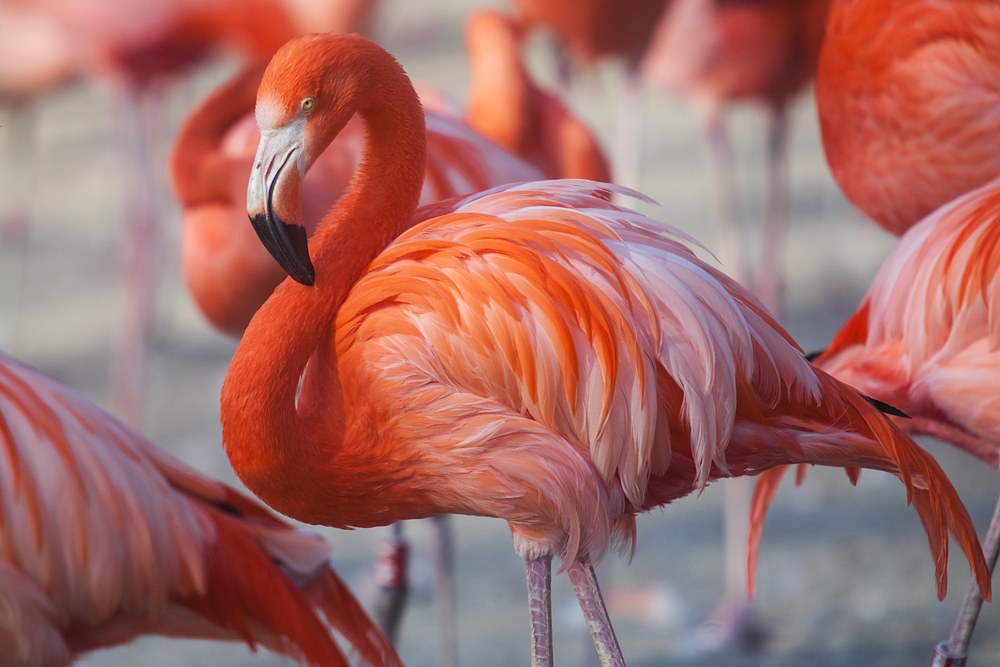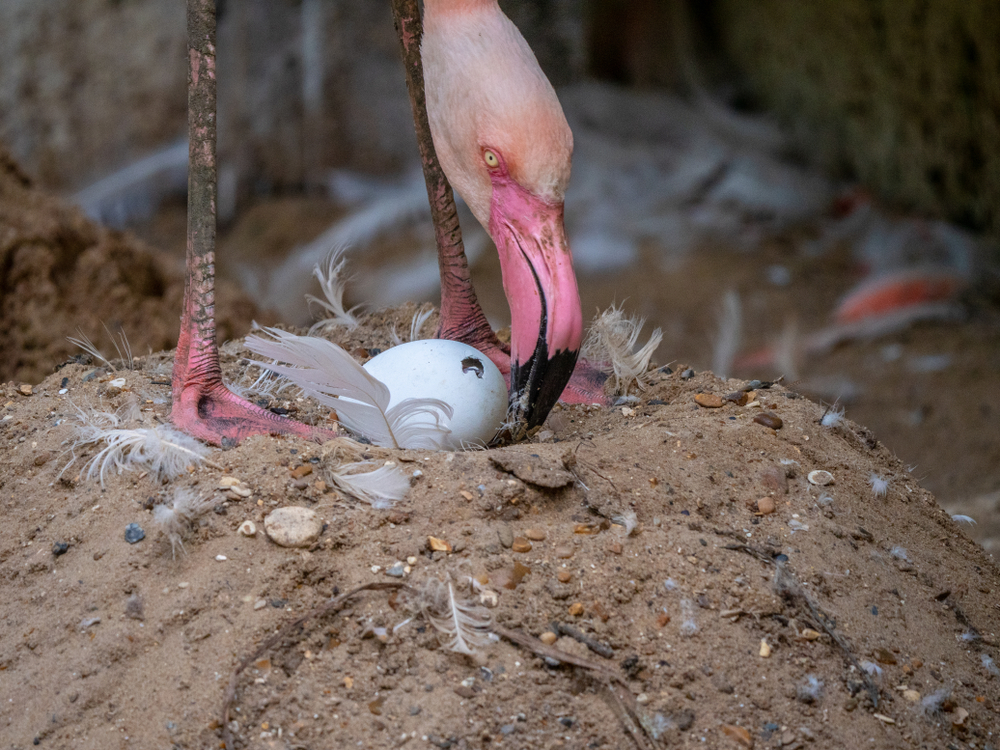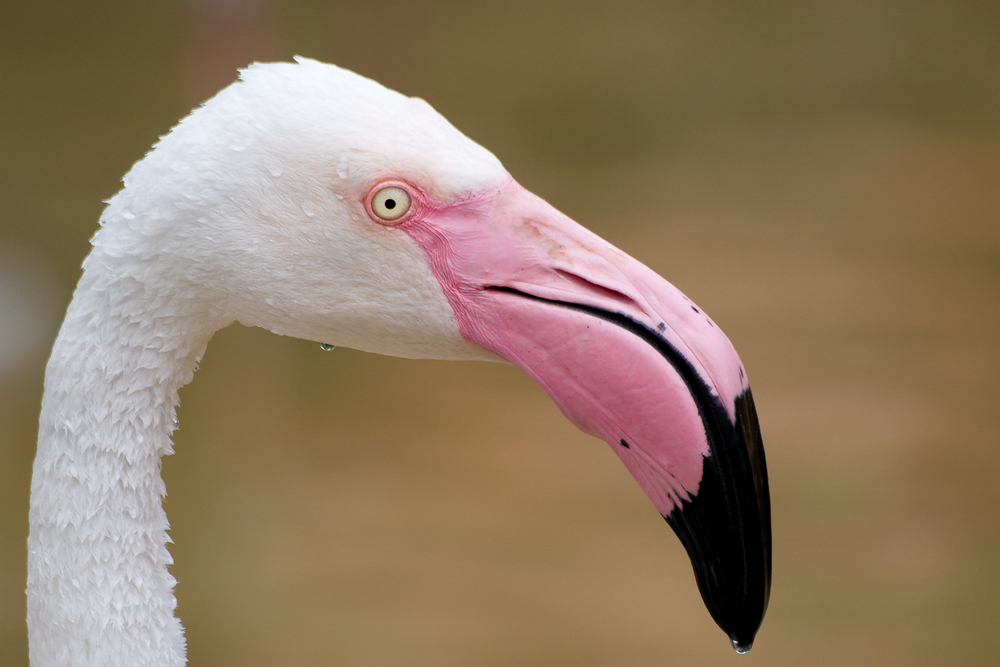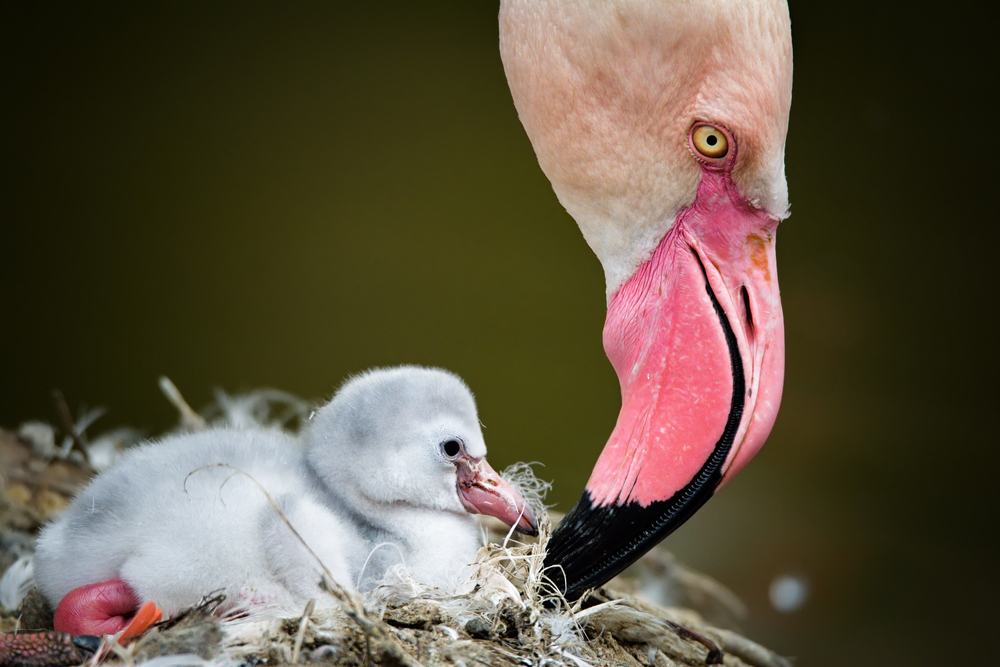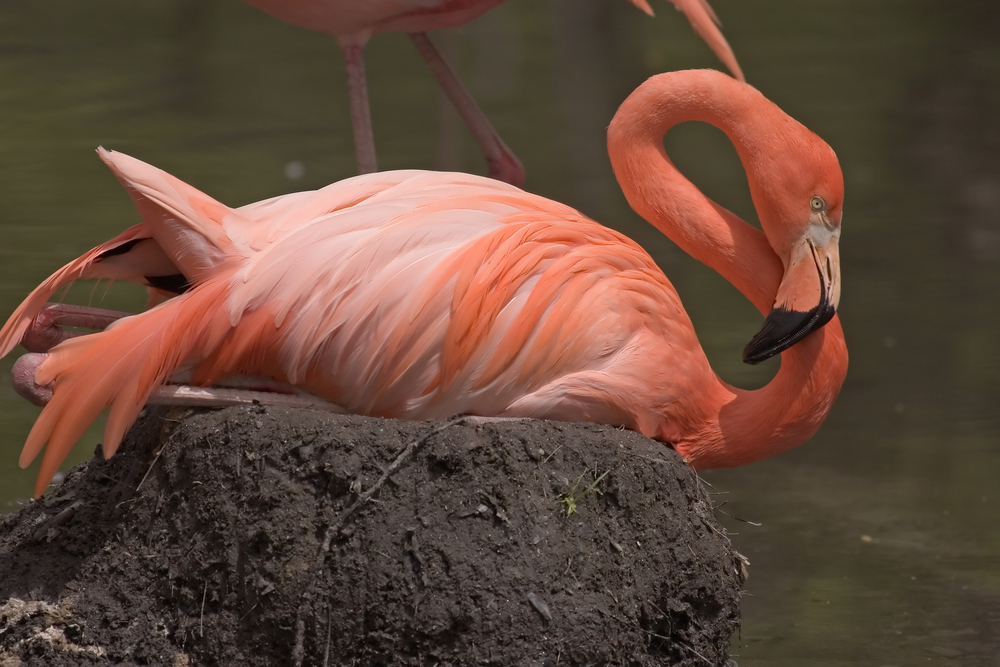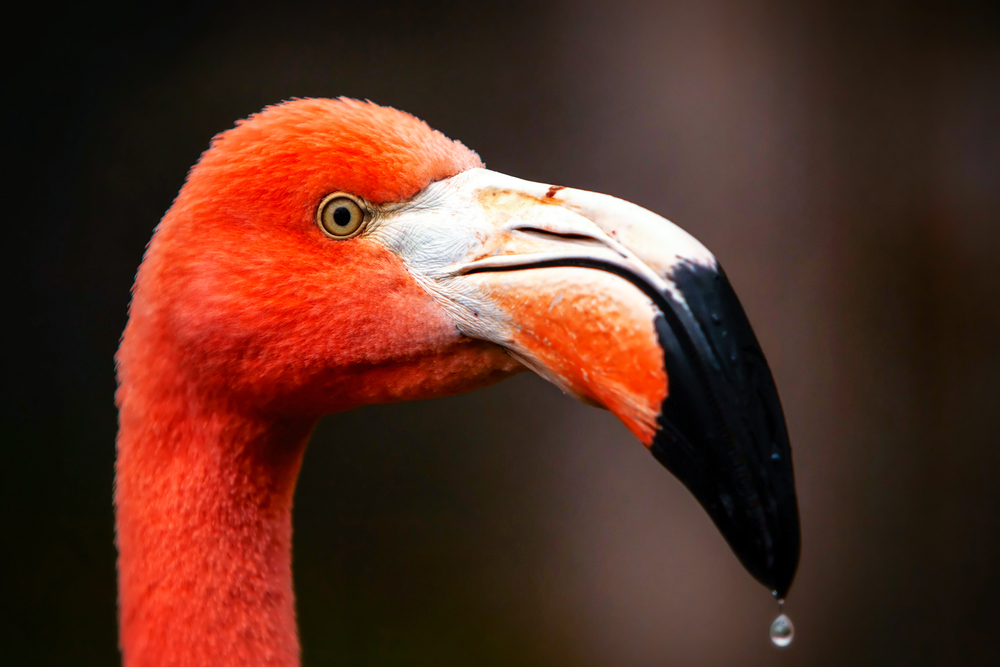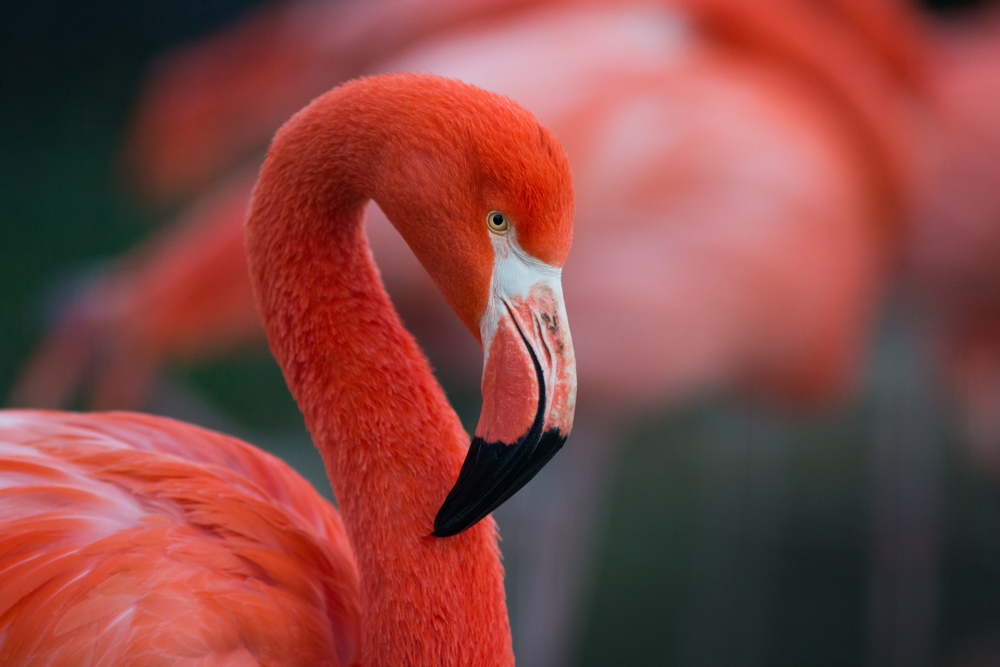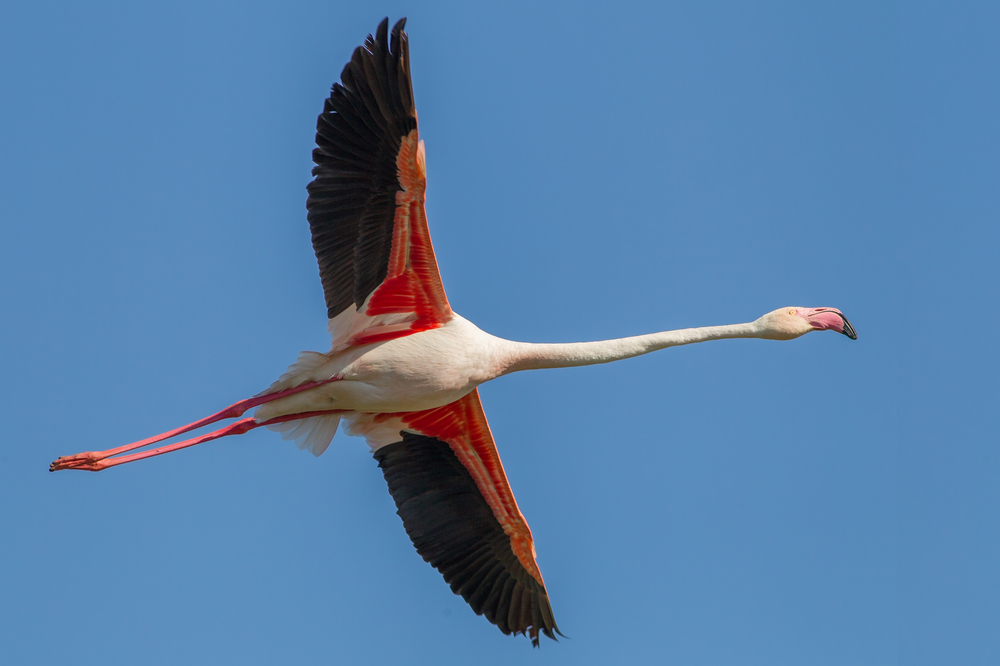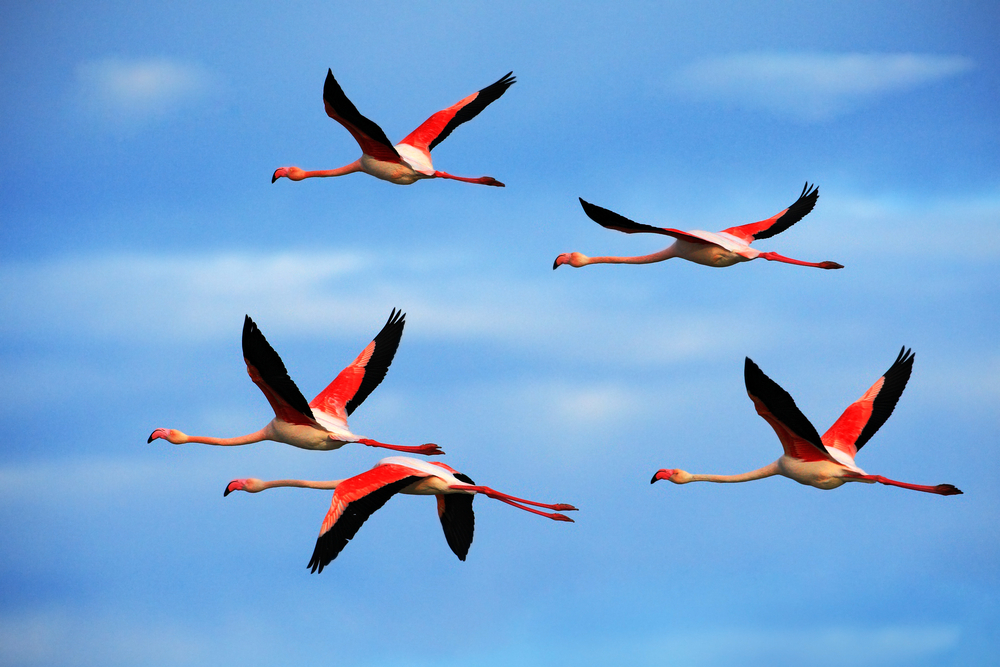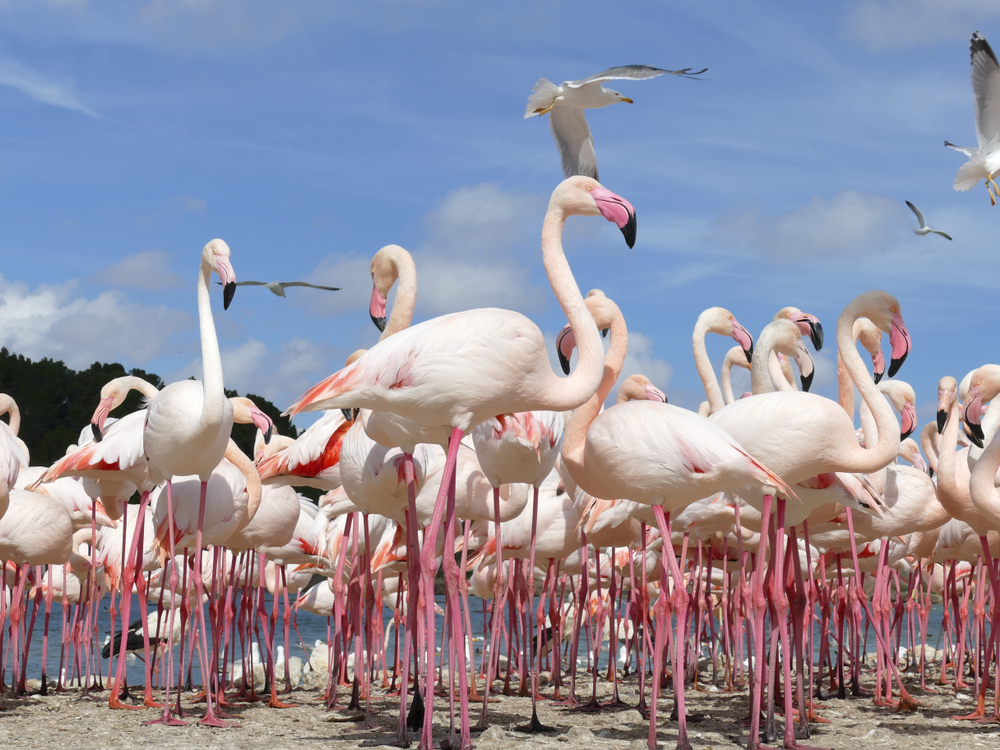About
The Flamingo, scientifically known as Phoenicopteridae, is a family of wading birds within the Animal Kingdom’s class Aves and order Phoenicopteriformes. They are known for their distinctive pink plumage, long necks, and unique bill shapes. Flamingos are distributed across various regions worldwide, including Africa, Asia, the Americas, and Europe.
There are six recognized species of Flamingos, including the Greater Flamingo, Lesser Flamingo, Chilean Flamingo, Andean Flamingo, James’s Flamingo, and American Flamingo. These species are characterized by their tall, slender bodies, long legs, and webbed feet, which make them well-adapted to wading in shallow waters.
Flamingos are social birds that often gather in large flocks, particularly during breeding and feeding periods. They are primarily filter feeders, using their specialized bill structures to filter small organisms such as algae, crustaceans, and small fish from the water.
During the breeding season, Flamingos form large colonies in coastal areas or saline lakes, where they build mud nest mounds and lay a single egg. Both parents take turns incubating the egg and caring for the chick after it hatches.
Conservation Concerns
While Flamingos are not considered globally threatened as a family, certain species and populations face conservation concerns. Habitat loss and degradation, pollution, disturbance by human activities, and climate change are among the primary threats to Flamingo populations.
The International Union for Conservation of Nature (IUCN) Red List classifies several Flamingo species as either near-threatened or least concern, depending on their population trends and conservation status. The Lesser Flamingo (Phoeniconaias minor) is classified as near-threatened due to habitat loss and disturbance at breeding sites, as well as threats from water pollution and changes in water levels.
Conservation efforts aimed at protecting Flamingo populations include habitat conservation and restoration, establishment of protected areas, monitoring of breeding colonies, and regulation of human activities in critical Flamingo habitats.
Physical Characteristics
The Flamingo, with its striking pink feathers and elegant stature, is one of the most recognizable birds in the world. There are six species of flamingos, with the Greater Flamingo (Phoenicopterus roseus) being the most widespread and the largest. These birds are found in regions ranging from the Americas to Africa, Europe, and Asia, inhabiting areas like shallow lakes, mangrove swamps, and sandy islands.
Size and Weight:
- Height: The Greater Flamingo, the tallest of the species, can stand 47 to 57 inches (120 to 145 centimeters) tall.
- Weight: These birds typically weigh between 4.4 to 8.8 pounds (2 to 4 kilograms), with some variation among the different species and individuals.
- Wingspan: Flamingos have a wingspan ranging from 55 to 65 inches (140 to 165 centimeters), facilitating their strong and capable flight.
Physical Characteristics:
- Feathers: The most iconic feature of flamingos is their vivid pink or reddish color, which comes from carotenoid pigments in their diet of algae, crustaceans, and plankton. The intensity of the coloration can vary widely among individuals and is a sign of the bird’s diet quality and overall health.
- Beak: Flamingos have a unique, downward-curving beak that allows them to filter feed. The upper beak is movable and fits tightly over the lower beak, which is fixed and contains a complex system of filters to sift food from water, mud, and silt.
- Legs and Feet: Their long, stilt-like legs and webbed feet are well adapted for wading in shallow waters. A flamingo’s legs are longer in relation to its body size than any other bird. They are known for their habit of standing on one leg, although the reason for this behavior is still a subject of scientific study.
- Neck: Flamingos have long, graceful necks, which they use to reach down into the water to feed. The neck has a series of flexible joints, allowing for a wide range of motion.
- Eyes: Their eyes are relatively large and located on the sides of their head, providing them with a broad field of vision to watch for predators while feeding.
- Social Behavior: Flamingos are highly social birds, often found in large flocks that can number in the thousands. These large groups help protect individuals from predators and aid in finding food.
- Flight: Despite their awkward appearance on land, flamingos are strong fliers. They take off with a running start to gain momentum and then flap their wings rapidly, flying with their neck and legs fully extended.
The Flamingo’s distinct appearance, from its colorful feathers to its long legs and unique feeding behavior, makes it an unforgettable sight in its natural habitat. Beyond their visual appeal, flamingos play a vital role in their ecosystems, contributing to the biodiversity of the wetlands they inhabit.
Reproduction
The reproductive cycle of flamingos is intricately linked to their habitat and environmental conditions. Here’s an overview:
Breeding Season: Flamingos typically breed during the wet season when suitable nesting sites are abundant and food resources are plentiful. The timing of the breeding season varies depending on the species and the specific location of their habitat.
Courtship Displays: Flamingos engage in elaborate courtship displays to attract mates and establish pair bonds. These displays often involve synchronized movements, vocalizations, and intricate dances performed by both males and females.
Nesting Behavior: Flamingos build their nests in large colonies, often on islands or mudflats in saline or alkaline lakes. The nest consists of a mound of mud, stones, and other materials, which helps elevate the eggs above potential floodwaters.
Egg Laying: Once a pair has bonded, the female lays a single egg, although some species may lay two eggs in a clutch. The egg is incubated by both parents, who take turns sitting on the nest to keep the egg warm and protected.
Incubation Period: The incubation period for flamingo eggs varies depending on the species but typically lasts around 28 to 32 days. During this time, the parents carefully tend to the egg, rotating it regularly to ensure uniform warmth.
Hatching and Chick Rearing: After the incubation period, the chick hatches from the egg. Flamingo chicks are precocial, meaning they are relatively mature and mobile at birth. Both parents feed the chick a specialized secretion known as crop milk, which provides essential nutrients for its growth and development.
Fledging: Flamingo chicks remain in the nest for several weeks to months, depending on the species. As they grow, they begin to explore their surroundings and may join creches with other chicks for protection.
Sexual Maturity: Flamingos reach sexual maturity at different ages depending on the species, typically between 3 to 6 years old. Once mature, they can participate in the breeding cycle and contribute to the survival of their species.
Conservation Concerns: Flamingos face various threats to their breeding success, including habitat loss, pollution, disturbance by humans, and predation. Conservation efforts focus on protecting critical breeding habitats, mitigating human impacts, and raising awareness about the importance of flamingo conservation.
Lifespan
Flamingos are iconic birds known for their vibrant plumage and distinctive long necks. They inhabit various wetland habitats across the world, where they form large flocks and feed on algae and small invertebrates. Here’s an overview of their lifespan and threats to their life:
Lifespan in the Wild: In their natural habitat, flamingos can live for an average of 20 to 30 years, although some individuals have been known to live longer, reaching up to 40 years or more. Their lifespan in the wild is influenced by factors such as predation, food availability, and habitat quality.
Lifespan in Captivity: Flamingos kept in captivity, such as those in zoos and wildlife parks, may have a longer lifespan compared to their wild counterparts. With access to regular food, veterinary care, and protection from predators, captive flamingos can live well into their 40s or even 50s.
Threats to Flamingos:
- Habitat Loss and Degradation: Destruction and alteration of wetland habitats, primarily due to urbanization, agriculture, and industrial development, pose significant threats to flamingos. Loss of nesting sites, feeding grounds, and suitable breeding habitats can disrupt their life cycle and reduce their overall population.
- Pollution: Pollution of water bodies, particularly from agricultural runoff, industrial waste, and sewage discharge, can contaminate flamingo habitats and affect water quality. Chemical pollutants and toxins can accumulate in their food sources, leading to health issues such as poisoning and reproductive abnormalities.
- Human Disturbance: Human activities such as recreational boating, tourism, and disturbance of nesting sites can stress and disrupt flamingo populations. Disturbances during breeding season can cause nest abandonment and reduce breeding success, ultimately impacting population growth.
- Climate Change: Climate change poses significant challenges to flamingo populations, affecting their habitat availability, food resources, and migration patterns. Rising temperatures, altered rainfall patterns, and sea-level rise can lead to habitat loss, changes in food availability, and increased competition with other species.
- Predation: Flamingo chicks and eggs are vulnerable to predation by various predators, including birds of prey, mammals, and reptiles. Nesting colonies located near predator-rich habitats are at higher risk of predation, leading to reduced breeding success and population decline.
Conservation efforts for flamingos focus on habitat conservation and restoration, pollution control, and mitigating human disturbances in critical breeding and feeding areas. Protected areas, wetland management plans, and international conservation agreements play a crucial role in safeguarding flamingo populations and their habitats.
Eating Habits
Flamingos are primarily filter feeders, relying on their specialized beaks to extract food from the water. Their diet consists mainly of:
- Algae and Plankton: Flamingos feed on small aquatic organisms such as algae, diatoms, and plankton. These microorganisms contain pigments called carotenoids, which contribute to the flamingos’ pink coloration.
- Crustaceans and Invertebrates: In addition to algae, flamingos also consume small crustaceans, mollusks, and aquatic invertebrates found in shallow waters. These provide essential nutrients such as proteins and fats necessary for their growth and energy requirements.
Feeding Behavior: Flamingos employ various feeding techniques to extract food from their aquatic environments:
- Filter Feeding: The characteristic curved beak of flamingos is adapted for filter feeding. They use their beak to sweep through the water, trapping small organisms and particles on specialized filtering structures called lamellae located inside their beaks. By filtering water through these structures, flamingos separate food from the surrounding water.
- Mud Piping: Flamingos often engage in a feeding behavior known as “mud piping.” They use their beaks to probe into soft mud or shallow waters, stirring up sediment and exposing hidden food items like small crustaceans and insect larvae.
Social Feeding: Flamingos are highly social birds and often feed in large groups called flocks. Group feeding serves multiple purposes:
- Safety: Feeding in large numbers provides safety in numbers, reducing the risk of predation from potential threats such as predators or rival species.
- Feeding Efficiency: Group feeding allows flamingos to cover more ground and efficiently locate food resources. They coordinate their movements to sweep through feeding areas, maximizing their foraging success.
Feeding Frequency: Flamingos typically feed throughout the day, with peaks in activity during the morning and evening hours. They may also adjust their feeding patterns based on environmental factors such as tides and water depth.
Special Considerations:
- Flamingos require access to shallow, alkaline or saline waters rich in algae and planktonic organisms to meet their dietary needs. Loss of suitable habitat due to habitat destruction or pollution can threaten their food sources and overall survival.
- The pink coloration of flamingos’ feathers is derived from the carotenoid pigments present in their diet. A lack of these pigments in their diet can lead to paler plumage in captivity. Therefore, it’s essential to provide captive flamingos with a diet rich in carotenoids to maintain their vibrant pink coloration and overall health.
Uniqueness
The Flamingo is one of the most easily recognizable birds due to its distinctive physical appearance and behavior. Here are some key aspects that make the Flamingo unique:
Striking Coloration: Flamingos are famous for their vivid pink or red feathers, a result of carotenoid pigments in their diet of algae, brine shrimp, and larva. The intensity of their coloration can vary widely among individuals and is directly influenced by their dietary intake of these pigments.
Unique Beak Structure: Flamingos have highly specialized beaks that are uniquely adapted for filter feeding. Their beaks are large, downturned, and equipped with lamellae (comb-like structures), which they use to sift mud and water for food. They feed by stirring up mud with their feet, then dipping their beaks upside down in the water to capture and filter out their prey.
Long Legs and Webbed Feet: With their exceptionally long legs, flamingos are able to wade deeper into water bodies than most other birds, giving them access to feeding areas that are otherwise unreachable. Their webbed feet support them in soft mud and help them stir up the bottom sediment to expose food sources.
Social Behavior: Flamingos are very social birds, often found in large flocks that can number in the thousands. These large groups help protect individuals from predators and enhance their efficiency in foraging. Social interactions include coordinated flock movements and communal breeding efforts.
Breeding and Nesting Habits: Flamingos are colonial nesters, with breeding colonies often located in inhospitable regions where predators are scarce. They construct mud towers, which can be as tall as 30 centimeters (12 inches), where each female lays a single egg. The height of these nests protects the egg from flooding and overheating.
Complex Mating Displays: Flamingos engage in elaborate group mating dances that include synchronized wing displays, head-flagging, and marching. These rituals are crucial for establishing pair bonds and synchronizing breeding within the colony.
Longevity and Migratory Patterns: Flamingos are known for their longevity, with life spans in the wild of up to 30 years, and even longer in captivity. Some species of flamingos are migratory, traveling long distances between breeding sites and favored feeding areas to take advantage of seasonal variations in food availability.
Conservation Status: While flamingos are not currently endangered, they are susceptible to threats from habitat loss, water pollution, and disturbance at breeding sites. Conservation efforts focus on protecting their natural habitats and ensuring sustainable conditions for their large breeding colonies.
The Flamingo’s iconic pink coloration, specialized feeding mechanism, and complex social structure make it one of the most interesting and photogenic birds in the natural world. Their presence enhances the biodiversity of their habitats and makes them a subject of fascination in both scientific research and popular culture.
Related Family Species
Sources
- Britannica, Flamingo, https://www.britannica.com/animal/flamingo-bird, retrieved March 2024.
- Burnie, David & Wilson, Don, Animal, Smithsonian Institute, Washington DC.
- Hickman et al, Integrated Principle of Zoology, McGraw Hill, Boston.






































































